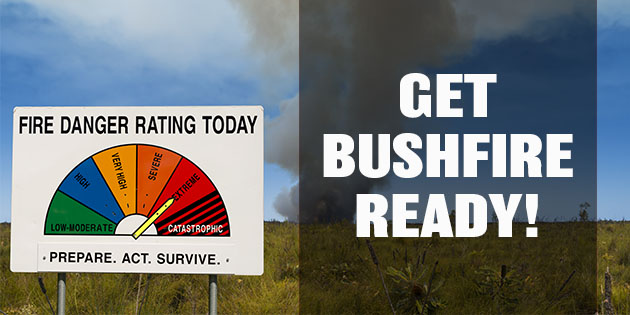
Everyone should be prepared for a possible bushfire...
...and we're helping you put together a customised list of tips to get prepared.
Become familar and take action on the tips that relate to your situation - it will be most! Don't get caught out.
This bushfire season, know your risk, prepare your property and make a Bushfire Survival Plan!
Tip: CLEAR DEBRIS AROUND YOUR HOME
If you live close to bushland, consider clearing trees and shrubs from within 30 meters around your home. Clear leaves, twigs, bark and other debris from your roof and gutters. Enclose open areas under decks and floors, and establish a mechanism to block gutters.
Tip: CLEAR EITHER SIDE OF YOUR DRIVEWAY
If you live close to bushland, and your house is set back from the road, consider clearing 2 meters either side of your driveway. This will allow you a safe way to leave your property in case of emergency, and an easy way for emergency services to safely access your property.
TIP: CHECK ON PUMPS, GENERATORS AND WATER SYSTEMS
If you live close to bushland, consider pointing your LPG cylinder gas valves away from the house, do maintenance checks on pumps, generators and water systems, seal all gaps in external roof and wall cladding, and display a prominent house or lot number to assist emergency services, if needed.
TIP: MOW YOUR GRASS REGULARLY
If you live close to bushland, consider mowing your grass on a regular basis, remove all excess ground fuels like dead leaves, branches and other combustible material, trim low-lying branches two meters from the ground surrounding your home, and make sure you have appropriate insurance for your home and vehicles.
TIP: INSTALL MESH SCREENS ON WINDOWS
If you live close to bushland, consider installing fine, steel wire mesh screens on all windows, doors, vents and weep holes with less than 2mm gaps. Mow your grass regularly, remove all excess ground fuels, and trim low-lying branches two meters from the ground surrounding your home.
TIP: FOLLOW TAS FIRE SERVICE ON SOCIAL MEDIA
If you live close to bushland, be aware of the community bushfire plan for your area, including nearby safety places. Your community plan can be accessed via the fire.tas.gov.au website, or by contacting your local Fire Brigade. You can follow the Tasmanian Fire Service on Facebook, Twitter and Instagram to keep abreast of the latest fire safety tips.
TIP: LEAVING EARLY IS ALWAYS THE BEST OPTION
On higher fire danger days or where there are fires in the landscape, leaving early is always the safest option. If you have time to do so safely, block drainpipes and fill your gutters with water, remove flammable items from the exterior of your house, pack your planned belongings into your car and leave in accordance with your plan.
TIP: FIND OUT WHAT COMMUNITY PLANS ARE IN PLACE
An informed, strong, resilient and bushfire ready community provides the foundation for a successful bushfire safety approach. Go to fire.tas.gov.au to find out if there are Community Bushfire Protection Plans, “Leave early Checklists” and Nearby Safer Places for your area. Source the right information to create your Bushfire Survival Plan and be bushfire Ready!
TIP: HAVE WORKING FIRE ALARMS AND AN ESCAPE PLAN
Ensure that your house is bushfire ready, test your smoke alarms, and talk to your family and prepare your home fire escape plan. If you know what to do before a fire, you are better equipped to deal with it if the situation arises. Go to fire.tas.gov.au for more information on where to best position your smoke alarms.
TIP: GET TO SAFETY BEFORE CALLING TRIPLE ZERO
It is important to get yourself and your family to safety before calling triple zero. When speaking to an operator stay calm and speak clearly. Give them the address of the fire, street number, street name, suburb and the nearest cross street. Remember in case of a fire – get out and stay out, then call triple zero.
TIP: PLAN AHEAD
Have a plan for what to do in the event of a fire, and think through issues you may need to prepare for. Make sure your firefighting equipment is regularly serviced and you know how to use it. It’s also important to store fire fighting equipment where it can be accessed in a hurry.
TIP: THE NATIONAL RELAY SERVICE CAN HELP YOU CONTACT EMERGENCY SERVICES
Remember in case of a fire – get out and stay out, then call triple zero. If you are hard of hearing or have a speech impairment, the national relay service provides 6 ways to contact emergency services. Go to fire.tas.gov.au for more information today so you are prepared.




